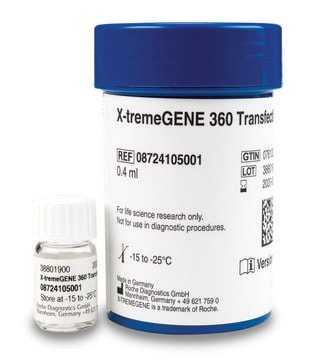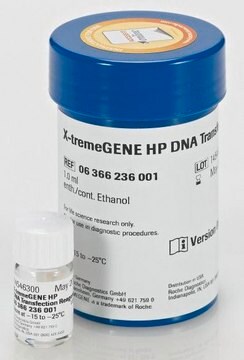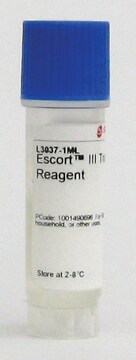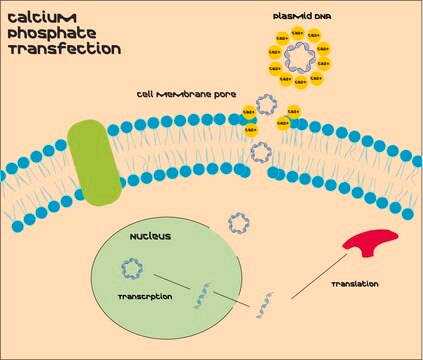XTG9-RO
Roche
Reactivo de transfección de ADN X-tremeGENE™ 9
Polymer reagent for transfecting common cell lines
About This Item
Productos recomendados
grade
for molecular biology
Quality Level
form
liquid (aqueous solution)
usage
mL (suitable for 165 transfections)
packaging
pkg of 0.4 mL (06365779001)
pkg of 1.0 mL (06365787001)
pkg of 5 × 1.0 mL (06365809001)
manufacturer/tradename
Roche
technique(s)
transfection: suitable
storage temp.
2-8°C
Categorías relacionadas
General description
Application
El reactivo de transfección del ADN X-tremeGENE™ 9 es idóneo para aplicaciones de análisis celular como:
- Expresión de proteínas recombinantes para análisis funcional.
- Estudios fisiológicos de las vías metabólicas.
- Análisis de secuencias reguladoras utilizando ensayos con genes.
- Ensayos de expresión génica.
- Estudios de investigación del cáncer.
- Evaluaciones específicas.
Features and Benefits
- Genera resultados fisiológicamente pertinentes utilizando un reactivo con una citotoxicidad extremadamente baja para una máxima viabilidad celular postransfección.
- Ahorra tiempo y elimina múltiples etapas de manipulación; sólo hay que diluir el reactivo de transfección de ADN X-tremeGENE 9, incubar con ADN plasmídico y pipetear le mezcla directamente en las células (con o sin suero).
- Evita procedimientos de optimización prolongados en las líneas celulares habitualmente utilizadas.
Quality
Physical form
Other Notes
Legal Information
Related product
signalword
Danger
hcodes
Hazard Classifications
Eye Irrit. 2 - Flam. Liq. 2
Storage Class
3 - Flammable liquids
wgk_germany
WGK 1
flash_point_f
334.4 °F
flash_point_c
168 °C
Certificados de análisis (COA)
Busque Certificados de análisis (COA) introduciendo el número de lote del producto. Los números de lote se encuentran en la etiqueta del producto después de las palabras «Lot» o «Batch»
¿Ya tiene este producto?
Encuentre la documentación para los productos que ha comprado recientemente en la Biblioteca de documentos.
Artículos
Automation is used for many applications to reduce variation caused by manual handling and to obtain reproducible results in high-throughput assays. High-throughput applications, such as knockdown studies or target screenings, often include cell transfection.
Small inhibitory RNAs (siRNAs) have become the focus of interest in many laboratories. For the first time, these molecules offer an easy way to knock down the expression of selected genes in mammalian cells without having to resort to classical gene knockout techniques.
Transfection is the introduction of DNA, RNA, or proteins into eukaryotic cells and is used in research to study and modulate gene expression. Thus, transfection techniques and protocols serve as an analytical tool that facilitates the characterization of genetic functions, protein synthesis, cell growth and development.
This brief webinar provides an overview of what transfection is and the methods that are used to introduce DNA or RNA into eukaryotic cells.
Protocolos
Plate cells approx. 24 hours before transfection making sure cells are at optimal concentration (70 – 90 % confluency).
Contenido relacionado
Browse our convenient transfection reagent selection guide to match the best reagent for your specific cell line and application needs.
Nuestro equipo de científicos tiene experiencia en todas las áreas de investigación: Ciencias de la vida, Ciencia de los materiales, Síntesis química, Cromatografía, Analítica y muchas otras.
Póngase en contacto con el Servicio técnico










